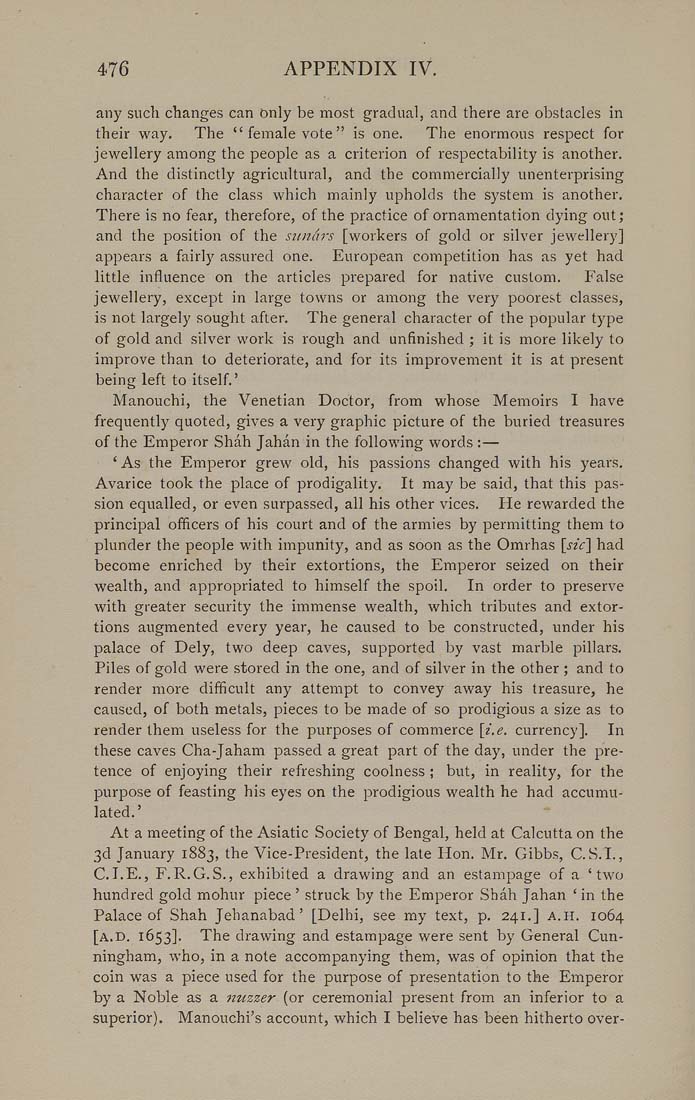476 APPENDIX IV.
any such changes can only be most gradual, and there are obstacles in
their way. The " female vote " is one. The enormous respect for
jewellery among the people as a criterion of respectability is another.
And the distinctly agricultural, and the commercially unenterprising
character of the class which mainly upholds the system is another.
There is no fear, therefore, of the practice of ornamentation dying out;
and the position of the sunars [workers of gold or silver jewellery]
appears a fairly assured one. European competition has as yet had
little influence on the articles i:>repared for native custom. False
jewellery, except in large towns or among the very poorest classes,
is not largely sought after. The general character of the popular type
of gold and silver work is rough and unfinished ; it is more likely to
improve than to deteriorate, and for its improvement it is at present
being left to itself.'
Manouchi, the Venetian Doctor, from whose Memoirs I have
frequently quoted, gives a very graphic picture of the buried treasures
of the Emperor Shah Jahan in the followdng words :—
'As the Emperor grew old, his passions changed with his years.
Avarice took the place of prodigality. It may be said, that this pas¬
sion equalled, or even surpassed, all his other vices. He rewarded the
principal officers of his court and of the armies by permitting them to
plunder the people with impunity, and as soon as the Omrhas [sic'\ had
become enriched by their extortions, the Emperor seized on their
wealth, and appropriated to himself the spoil. In order to preserve
with greater security the immense wealth, which tributes and extor¬
tions augmented every year, he caused to be constructed, under his
palace of Dely, two deep caves, supported by vast marble pillars.
Piles of gold were stored in the one, and of silver in the other ; and to
render more difficult any attempt to convey away his treasure, he
caused, of both metals, pieces to be made of so prodigious a size as to
render them useless for the purposes of commerce {i.e. currency]. In
these caves Cha-Jaham passed a great part of the day, under the pre¬
tence of enjoying their refreshing coolness ; but, in reality, for the
purpose of feasting his eyes on the prodigious wealth he had accumu¬
lated.'
At a meeting of the Asiatic Society of Bengal, held at Calcutta on the
3d January 1883, the Vice-President, the late Hon. Mr. Gibb.s, C.S.I.,
CLE., F.R.G.S., exhibited a drawing and an estampage of a 'two
hundred gold mohur piece ' struck hy the Emperor Shah Jahan ' in the
Palace of Shah Jehanabad' [Delhi, see my text, p. 241.] A.H. 1064
[A.D. 1653]. The drawing and estampage were sent by General Cun¬
ningham, who, in a note accompanying them, was of opinion that the
coin was a piece used for the purpose of presentation to the Emperor
by a Noble as a nuzzer (or ceremonial present from an inferior to a
superior). Manouchi's account, which I believe has been hitherto over-
|








